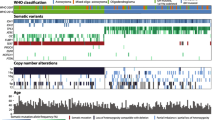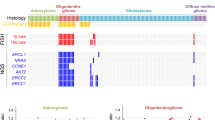Abstract
TP53 is a pivotal gene frequently mutated in diffuse gliomas and particularly in astrocytic tumors. The majority of studies dedicated to TP53 in gliomas were focused on mutational hotspots located in exons 5–8. Recent studies have suggested that TP53 is also mutated outside the classic mutational hotspots reported in gliomas. Therefore, we have sequenced all TP53 coding exons in a retrospective series of 61 low grade gliomas (LGG) using high throughput sequencing technology. In addition, TP53 mutational status was correlated with: (i) p53 expression, (ii) tumor type, (iii) chromosome arms 1p/19q status and (iv) clinical features of patients. The cohort included 32 oligodendrogliomas (O), 21 oligoastrocytomas (M) and 8 astrocytomas (A). TP53 mutation was detected in 52.4 % (32/61) of tumors (34 % of O, 71.4 % of M and 75 % of A). All mutations (38 mutations in 32 samples) were detected in exons 4, 5, 6, 7, 8 and 10. Missense and non-missense mutations, including seven novel mutations, were detected in 42.6 and 9.8 % of tumors respectively. TP53 mutations were almost mutually exclusive with 1p/19q co-deletion and were associated with: (i) astrocytic phenotype, (ii) younger age, (iii) p53 expression. Using a threshold of 10 % p53-positive tumor cells, p53 expression is an interesting surrogate marker for missense TP53 mutations (Se = 92 %; Sp = 79.4 %) but not for non-missense mutation (18.4 % of mutations). TP53 and p53 statuses were not prognostic in LGG. In conclusion, we have identified novel TP53 mutations in LGG. TP53 mutations outside exons 4–8 are rare. Although it remains imperfect, p53 expression with a threshold of 10 % is a good surrogate marker for missense TP53 mutations and appears helpful in the setting of LGG phenotype diagnosis.




Similar content being viewed by others
References
Muller PA, Vousden KH (2013) p53 mutations in cancer. Nat Cell Biol 15:2–8
Louis DN et al (2007) The 2007 WHO classification of tumours of the central nervous system. Acta Neuropathol 114:97–109
Watanabe K et al (1997) Incidence and timing of p53 mutations during astrocytoma progression in patients with multiple biopsies. Clin Cancer Res 3:523–530
Nozaki M et al (1999) Roles of the functional loss of p53 and other genes in astrocytoma tumorigenesis and progression. Neuro Oncol 1:124–137
Okamoto Y et al (2004) Population-based study on incidence, survival rates, and genetic alterations of low-grade diffuse astrocytomas and oligodendrogliomas. Acta Neuropathol 108:49–56
Zheng H et al (2008) p53 and Pten control neural and glioma stem/progenitor cell renewal and differentiation. Nature 455:1129–1133
Robles AI, Harris CC (2010) Clinical outcomes and correlates of TP53 mutations and cancer. Cold Spring Harb Perspect Biol 2:a001016
Hartmann C et al (2011) Molecular markers in low-grade gliomas: predictive or prognostic? Clin Cancer Res 17:4588–4599
Bourne TD, Schiff D (2010) Update on molecular findings, management and outcome in low-grade gliomas. Nat Rev Neurol 6:695–701
Peraud A, Kreth FW, Wiestler OD, Kleihues P, Reulen H-J (2002) Prognostic impact of TP53 mutations and P53 protein overexpression in supratentorial WHO grade II astrocytomas and oligoastrocytomas. Clin Cancer Res 8:1117–1124
Ständer M, Peraud A, Leroch B, Kreth FW (2004) Prognostic impact of TP53 mutation status for adult patients with supratentorial World Health Organization Grade II astrocytoma or oligoastrocytoma: a long-term analysis. Cancer 101:1028–1035
Reyes-Botero G et al (2014) Molecular analysis of diffuse intrinsic brainstem gliomas in adults. J Neurooncol 116:405–411
Idbaih A et al (2007) TP53 codon 72 polymorphism, p53 expression, and 1p/19q status in oligodendroglial tumors. Cancer Genet Cytogenet 177:103–107
Labussiere M et al (2010) All the 1p19q codeleted gliomas are mutated on IDH1 or IDH2. Neurology 74:1886–1890
Kim Y-H et al (2010) Molecular classification of low-grade diffuse gliomas. Am J Pathol 177:2708–2714
Von Deimling A et al (1992) p53 mutations are associated with 17p allelic loss in grade II and grade III astrocytoma. Cancer Res 52:2987–2990
Ohgaki H et al (1993) Mutations of the p53 tumor suppressor gene in neoplasms of the human nervous system. Mol Carcinog 8:74–80
Del Arco A et al (1993) Timing of p53 mutations during astrocytoma tumorigenesis. Hum Mol Genet 2:1687–1690
Kraus JA et al (1994) TP53 alterations and clinical outcome in low grade astrocytomas. Genes Chromosomes Cancer 10:143–149
Hsieh LL, Hsia CF, Wang LY, Chen CJ, Ho YS (1994) p53 gene mutations in brain tumors in Taiwan. Cancer Lett 78:25–32
Chozick BS et al (1994) Pattern of mutant p53 expression in human astrocytomas suggests the existence of alternate pathways of tumorigenesis. Cancer 73:406–415
Patt S et al (1996) p53 gene mutations in human astrocytic brain tumors including pilocytic astrocytomas. Hum Pathol 27:586–589
Hagel C et al (1996) Demonstration of p53 protein and TP53 gene mutations in oligodendrogliomas. Eur J Cancer 32A:2242–2248
Weber RG et al (1996) Characterization of genomic alterations associated with glioma progression by comparative genomic hybridization. Oncogene 13:983–994
Hwang SL et al (1999) Expression and mutation analysis of the p53 gene in astrocytoma. J Formos Med Assoc 98:31–38
Ishii N et al (1999) Cells with TP53 mutations in low grade astrocytic tumors evolve clonally to malignancy and are an unfavorable prognostic factor. Oncogene 18:5870–5878
Bigner SH et al (1999) Molecular genetic aspects of oligodendrogliomas including analysis by comparative genomic hybridization. Am J Pathol 155:375–386
James CD et al (1999) Tumor suppressor gene alterations in malignant gliomas: histopathological associations and prognostic evaluation. Int J Oncol 15:547–553
Jin W, Xu X, Yang T, Hua Z (2000) p53 mutation, EGFR gene amplification and loss of heterozygosity on chromosome 10, 17 p in human gliomas. Chin Med J 113:662–666
Kösel S, Scheithauer BW, Graeber MB (2001) Genotype-phenotype correlation in gemistocytic astrocytomas. Neurosurgery 48:187–193 discussion 193–194
Calogero A et al (2001) The early growth response gene EGR-1 behaves as a suppressor gene that is down-regulated independent of ARF/Mdm2 but not p53 alterations in fresh human gliomas. Clin Cancer Res 7:2788–2796
Chawengchao B et al (2001) Detection of a novel point mutation in the p53 gene in grade II astrocytomas by PCR-SSCP analysis with additional Klenow treatment. Anticancer Res 21:2739–2743
Ueki K et al (2002) Correlation of histology and molecular genetic analysis of 1p, 19q, 10q, TP53, EGFR, CDK4, and CDKN2A in 91 astrocytic and oligodendroglial tumors. Clin Cancer Res 8:196–201
Rasheed A et al (2002) Molecular markers of prognosis in astrocytic tumors. Cancer 94:2688–2697
Watanabe T, Katayama Y, Yoshino A, Komine C, Yokoyama T (2003) Deregulation of the TP53/p14ARF tumor suppressor pathway in low-grade diffuse astrocytomas and its influence on clinical course. Clin Cancer Res 9:4884–4890
Ono Y et al (1997) Accumulation of wild-type p53 in astrocytomas is associated with increased p21 expression. Acta Neuropathol 94:21–27
Watanabe K et al (1998) p53 and PTEN gene mutations in gemistocytic astrocytomas. Acta Neuropathol 95:559–564
Hulsebos TJM, Troost D, Leenstra S (2004) Molecular-genetic characterisation of gliomas that recur as same grade or higher grade tumours. J. Neurol Neurosurg Psychiatr 75:723–726
Yusoff AA, Abdullah J, Abdullah MR, Mohd Ariff AR, Isa MN (2004) Association of p53 tumor suppressor gene with paraclinical and clinical modalities of gliomas patients in Malaysia. Acta Neurochir (Wien) 146:595–601
Mueller W, Lass U, Wellmann S, Kunitz F, von Deimling A (2005) Mutation analysis of DKK1 and in vivo evidence of predominant p53-independent DKK1 function in gliomas. Acta Neuropathol 109:314–320
Qu M et al (2007) Genetically distinct astrocytic and oligodendroglial components in oligoastrocytomas. Acta Neuropathol 113:129–136
Ren Z-P et al (2007) Molecular genetic analysis of p53 intratumoral heterogeneity in human astrocytic brain tumors. J Neuropathol Exp Neurol 66:944–954
Jeon YK et al (2007) Chromosome 1p and 19q status and p53 and p16 expression patterns as prognostic indicators of oligodendroglial tumors: a clinicopathological study using fluorescence in situ hybridization. Neuropathology 27:10–20
Mellai M et al (2011) IDH1 and IDH2 mutations, immunohistochemistry and associations in a series of brain tumors. J Neurooncol 105:345–357
Groenendijk FH et al (2011) MGMT promoter hypermethylation is a frequent, early, and consistent event in astrocytoma progression, and not correlated with TP53 mutation. J Neurooncol 101:405–417
Pardo FS et al (2004) Mutant, wild type, or overall p53 expression: freedom from clinical progression in tumours of astrocytic lineage. Br J Cancer 91:1678–1686
Adzhubei IA et al (2010) A method and server for predicting damaging missense mutations. Nat Methods 7:248–249
Ricard D et al (2012) Primary brain tumours in adults. Lancet 379:1984–1996
Faria MHG et al (2012) TP53 mutations in astrocytic gliomas: an association with histological grade, TP53 codon 72 polymorphism and p53 expression. APMIS 120:882–889
Takano S et al (2012) Immunohistochemical detection of IDH1 mutation, p53, and internexin as prognostic factors of glial tumors. J Neurooncol 108:361–373
Hirose T, Ishizawa K, Shimada S (2010) Utility of in situ demonstration of 1p loss and p53 overexpression in pathologic diagnosis of oligodendroglial tumors. Neuropathology 30:586–596
Figarella-Branger D et al (2012) Molecular genetics of adult grade II gliomas: towards a comprehensive tumor classification. J Neurooncol 110:205–2013
Acknowledgments
The research leading to these results received funding from the program “Investissements d’avenir” ANR-10-IAIHU-06. AA has been granted by “Obra Social la Caixa” and ARTC (Association pour la Recherche sur les Tumeurs Cérébrales).
Conflict of interest
The authors have no conflicts of interest to declare.
Author information
Authors and Affiliations
Corresponding author
Electronic supplementary material
Below is the link to the electronic supplementary material.
Rights and permissions
About this article
Cite this article
Gillet, E., Alentorn, A., Doukouré, B. et al. TP53 and p53 statuses and their clinical impact in diffuse low grade gliomas. J Neurooncol 118, 131–139 (2014). https://doi.org/10.1007/s11060-014-1407-4
Received:
Accepted:
Published:
Issue Date:
DOI: https://doi.org/10.1007/s11060-014-1407-4




